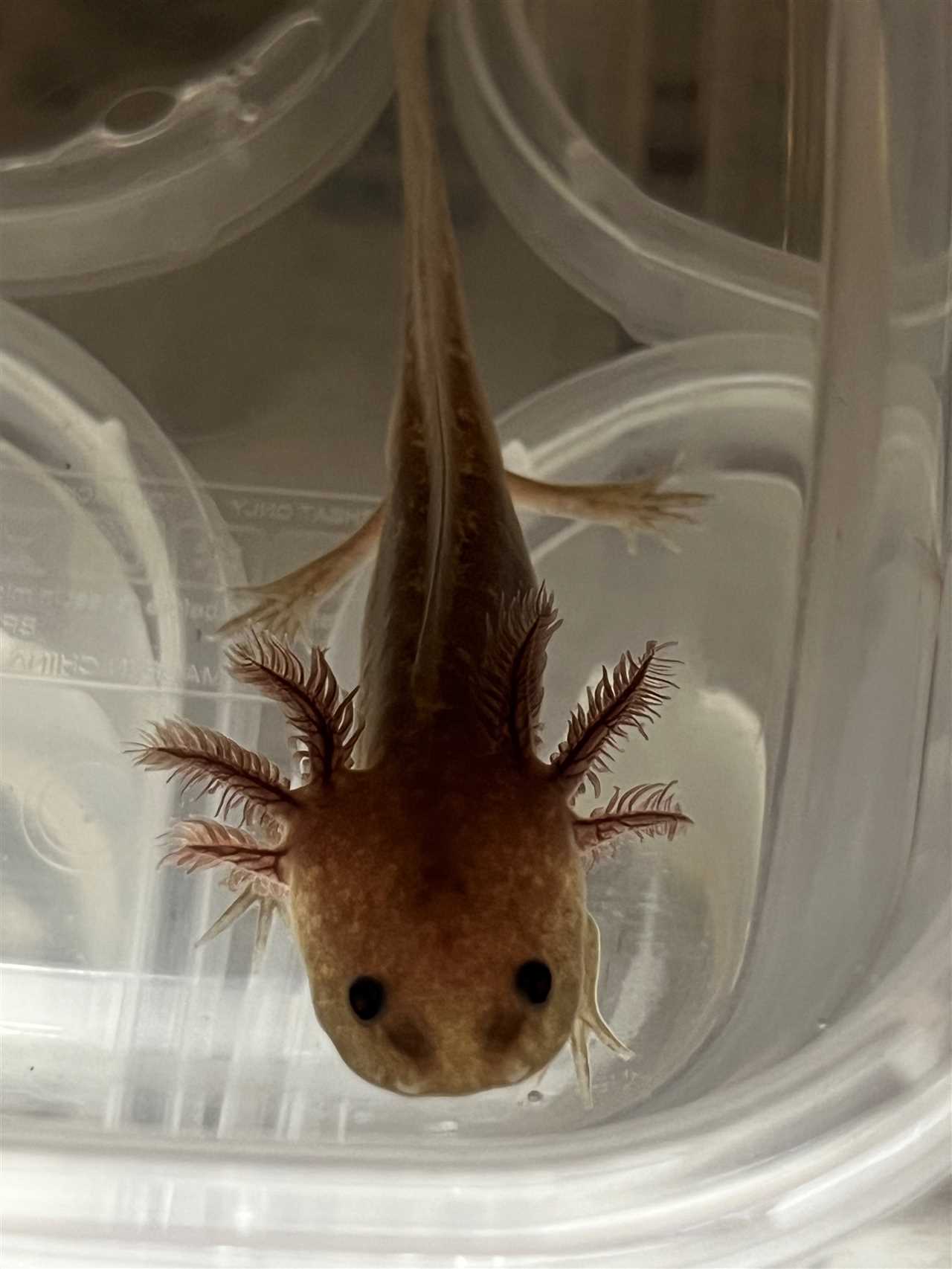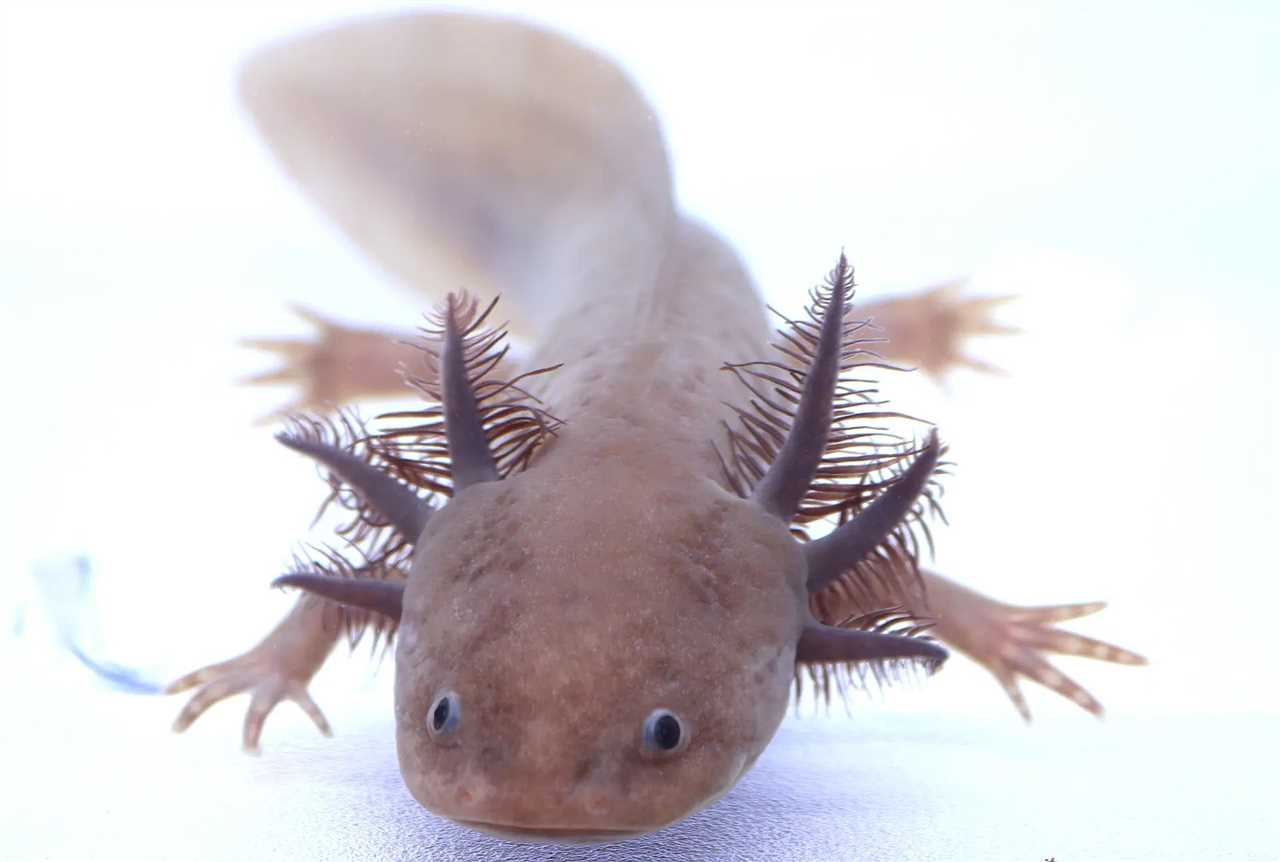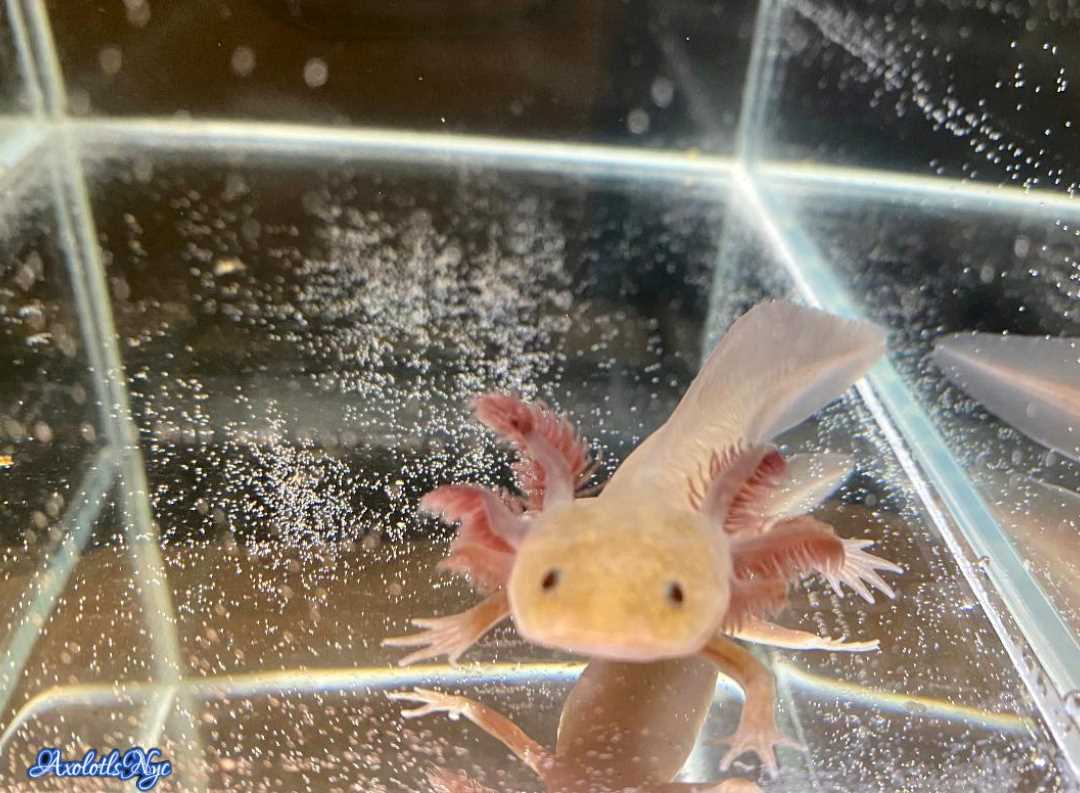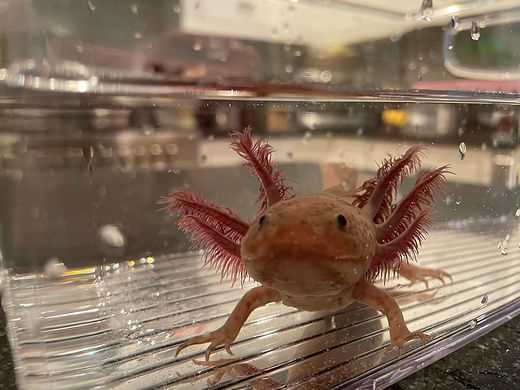
The copper melanoid morph of the axolotl is highly sought after by enthusiasts due to its unique appearance. It features a vibrant copper coloration that glistens under the light, giving it a mesmerizing beauty. The copper melanoid axolotl often has dark eyes and a slightly lighter underbelly, adding to its overall charm.
Keeping a copper melanoid axolotl requires a well-maintained aquatic habitat with clean water and a suitable diet. They are carnivorous and primarily feed on small invertebrates and worms. Regular water changes and proper filtration are essential for their health and well-being. Additionally, providing them with hiding spots, like plants or caves, allows them to feel secure in their environment.
The copper melanoid axolotl is not only a stunning creature to behold but also an important species for scientific research. Its regenerative abilities have piqued the interest of scientists studying tissue regeneration and potential medical applications. With its unique coloration and remarkable regenerative abilities, the copper melanoid axolotl is truly a captivating amphibian that continues to amaze and intrigue enthusiasts and scientists alike.
The Rare and Beautiful Copper Melanoid Axolotl
The copper melanoid axolotl is a unique morph of the popular Mexican axolotl (Ambystoma mexicanum), an amphibian that is known for its gilled and aquatic nature. With its stunning copper coloration and melanoid trait, this axolotl stands out as a truly extraordinary species.
What sets the copper melanoid axolotl apart is its distinct copper-colored skin, which ranges from bright orange to deep reddish-brown. This vibrant coloration is a result of its genetic mutation, making it a highly sought-after variant among axolotl enthusiasts.
In addition to its striking appearance, the copper melanoid axolotl shares many of the remarkable characteristics that make axolotls so fascinating. These salamanders have the ability to regenerate their limbs, spinal cord, heart, and even parts of their brain. This unique regenerative ability makes them a subject of scientific research and a popular choice for amphibian enthusiasts.
| Characteristics | Details |
|---|---|
| Scientific Name | Ambystoma mexicanum |
| Common Name | Copper Melanoid Axolotl |
| Morph | Copper-colored with melanoid trait |
| Habitat | Aquatic environments, such as lakes and ponds |
| Feeding | Carnivorous diet, primarily consisting of small fish and invertebrates |
| Care | Requires a well-maintained aquarium with proper filtration and temperature control |
| Breeding | Can reproduce through both sexual and asexual reproduction |
| Health | Generally hardy, but susceptible to certain diseases and water quality issues |
The copper melanoid axolotl is a captivating creature that combines beauty with extraordinary regenerative abilities. Whether you are a seasoned axolotl owner or a beginner, this unique morph is sure to catch your attention and leave you in awe of nature’s wonders.
What is a Copper Melanoid Axolotl?
The Copper Melanoid Axolotl is a unique amphibian that belongs to the group of salamanders. It is a morph of the axolotl species, which is known for its remarkable regenerative abilities. The Copper Melanoid Axolotl gets its name from its stunning copper-colored skin and the absence of melanin, which gives it a distinctive appearance.
Regeneration Abilities:
In addition to regenerating lost body parts, the Copper Melanoid Axolotl can also regenerate damaged organs. This makes it a valuable model for studying regenerative medicine and finding potential treatments for human diseases and injuries.
Gilled Amphibian:
As mentioned earlier, the Copper Melanoid Axolotl retains its gills throughout its life. These gills allow it to extract oxygen from the water, making it an efficient aquatic creature. It also has a fully functional respiratory system, which allows it to breathe through its gills.
The gills of the Copper Melanoid Axolotl are feathery and delicate, enabling it to extract oxygen efficiently from the water. This unique adaptation allows the axolotl to thrive in its natural habitat and makes it a popular choice for amphibian enthusiasts.
Characteristics of the Copper Melanoid Axolotl
The copper melanoid axolotl is a unique morph of the axolotl, a type of salamander that is known for its ability to regenerate body parts. It is a fascinating amphibian with gilled larvae that never undergo metamorphosis, allowing it to remain fully aquatic throughout its life.
The distinctive feature of the copper melanoid axolotl is its beautiful copper-colored skin. This coloration is a result of a genetic mutation that affects the production of melanin, the pigment responsible for skin color. Unlike other axolotl morphs, which can exhibit a variety of colors, the copper melanoid has a consistent and striking copper hue.
Regeneration and Adaptation
One of the most captivating traits of the axolotl is its incredible regenerative abilities. Unlike most organisms, which can only regenerate certain body parts, axolotls can regenerate almost any part of their body, including limbs, spinal cord, heart, and even parts of the brain. This ability makes them invaluable for scientific research in regenerative medicine.
In addition to their regenerative capabilities, axolotls have adapted to their aquatic habitat in various ways. They have developed elongated bodies with stumpy legs and a fin-like tail, which allows them to propel themselves through the water with ease. Their gills enable them to extract oxygen from the water, eliminating the need for lungs.
Care and Maintenance
Keeping a copper melanoid axolotl requires a suitable aquatic environment that mimics its natural habitat. This includes a spacious tank with clean, dechlorinated water, appropriate filtration, and a temperature range of 16-18 degrees Celsius. It is essential to provide hiding places and aquatic plants for the axolotl to explore and hide in.
Regular water testing and maintenance are also crucial to ensure the health and well-being of the axolotl. Ammonia and nitrate levels should be kept in check, and regular water changes should be performed to maintain water quality.
Overall, caring for a copper melanoid axolotl requires dedication and attention to detail. With proper care, these unique amphibians can live a long and healthy life, bringing joy and fascination to their owners.
The Aquatic Salamander with Remarkable Regeneration Abilities: The Copper Melanoid Axolotl
The Copper Melanoid Axolotl is a unique and fascinating aquatic amphibian that captivates with its striking appearance and remarkable abilities. With its gilled morph and cutaneous melanoid pigmentation, this species stands out among other axolotls.
One of the most intriguing features of the copper melanoid axolotl is its regenerative abilities. Regeneration is a unique characteristic of axolotls, enabling them to regrow entire limbs, organs, and even parts of their spinal cord. This remarkable ability has made them a subject of extensive research within the fields of regenerative medicine and biology.
The natural habitat of the copper melanoid axolotl is the ancient water system of Lake Xochimilco, located in Mexico City. This species thrives in the cool, shallow waters of the lake, where it can find ample food supply and suitable conditions for its survival.
In terms of diet and feeding habits, the copper melanoid axolotl is a carnivorous species. Its diet primarily consists of small invertebrates, such as worms, insects, and crustaceans. Being an amphibian, its feeding methods include suctioning prey into its mouth and swallowing them whole.
As for breeding and reproduction, copper melanoid axolotls reproduce through external fertilization. Females lay their eggs, and males then release sperm to fertilize them. Breeding axolotls requires careful monitoring of water conditions, temperature, and providing suitable hiding spots for the females to lay their eggs.
Ensuring the health and well-being of the copper melanoid axolotl involves regular monitoring and maintenance of their habitat, including water quality testing, ensuring proper nutrition, and promptly addressing any signs of illness or disease. Common health concerns for axolotls include fungal infections, bacterial diseases, and parasitic infestations.
The copper melanoid axolotl is not a species that faces immediate conservation concerns. However, the preservation of their natural habitat, such as Lake Xochimilco, is essential for their long-term survival and maintaining the biodiversity of the region.
Feeding and Diet
Gilled amphibians, like the copper melanoid axolotl, have a unique ability to regenerate their limbs, organs, and even parts of their central nervous system. This makes them a fascinating and popular choice for amphibian enthusiasts. The copper melanoid axolotl is a specific morph of the axolotl species, which is a type of salamander.
Copper melanoid axolotls are primarily carnivorous, and their diet should consist mainly of high-protein and low-fat food sources. It is recommended to feed them 2-3 times a week, with the amount depending on the size and age of the axolotl. Overfeeding should be avoided as it can lead to obesity and potential health issues.
When feeding the copper melanoid axolotl, it is best to offer food that is smaller than the width of their head to prevent choking. Live food should be moved around to stimulate their natural hunting instincts, as axolotls are opportunistic predators. It is also important to remove any uneaten food after feeding to maintain good water quality.
In addition to live food, commercial axolotl pellets can be included in their diet as a supplementary source of nutrition. These pellets are specifically formulated to meet the dietary requirements of axolotls and may contain ingredients such as fish meal, shrimp meal, and spirulina.
Overall, maintaining a balanced and nutritious diet is essential for the health and well-being of the copper melanoid axolotl. By providing a variety of live and commercial food options, as well as maintaining proper water conditions, owners can ensure the longevity and vibrancy of their unique and stunning copper melanoid axolotl.
Care and Maintenance
Proper care and maintenance are essential for keeping a Copper Melanoid Axolotl happy and healthy. Here are some important tips to consider:
Tank Setup
When setting up a tank for your Copper Melanoid Axolotl, it is crucial to recreate its natural habitat as closely as possible. The tank should be spacious enough to allow the axolotl to move around comfortably. A 20-gallon tank is usually sufficient for a single adult axolotl.
The water temperature should be kept between 60-68°F (16-20°C) to mimic the axolotl’s natural environment. A heater can be used to maintain a stable temperature.
Food and Diet
Copper Melanoid Axolotls are carnivorous and primarily feed on live or frozen foods. Their diet should consist of small earthworms, bloodworms, brine shrimp, and other small aquatic invertebrates. It is essential to provide a varied diet to ensure all nutritional needs are met.
Feed your axolotl 2-3 times a week, offering an amount of food that can be consumed within 5 minutes. It is essential not to overfeed, as this can lead to obesity and poor health.
Water Quality
Maintaining excellent water quality is crucial for the health of your Copper Melanoid Axolotl. Regular water changes should be performed to remove any waste or toxins that may accumulate in the tank.
The water should be dechlorinated before adding it to the tank, as chlorine and other chemicals can be harmful to axolotls. A water conditioner can be used to remove these harmful substances.
It is also essential to monitor the pH and ammonia levels in the tank regularly. The pH should be kept between 6.5-8.0, and ammonia levels should be kept at 0ppm.
Handling and Tankmates
Copper Melanoid Axolotls are delicate creatures and should be handled with care. Always use wet hands or a soft net when transferring them from one location to another. Never grab them by their limbs or tail, as this can result in injury or stress.
Axolotls are generally solitary animals and prefer to live alone. They can become stressed or aggressive if housed with other tankmates. If you choose to add tankmates, make sure they are compatible and won’t harm or stress the axolotl.
Providing hiding spots, such as rocks, plants, or caves, can help reduce stress and provide a sense of security.
By following these care and maintenance guidelines, you can ensure that your Copper Melanoid Axolotl thrives in its aquatic environment and remains healthy for years to come.
Breeding and Reproduction
After fertilization, the female will lay her eggs, which can range from a few dozen to several hundred, depending on her size and age. The eggs are typically attached to plants or other surfaces in the aquarium to protect them from being eaten by the parents or other tank inhabitants. The eggs hatch within a few weeks, and the young axolotls emerge as gilled larvae.
Overall, the breeding and reproduction of the Copper Melanoid Axolotl is a captivating process that showcases the unique characteristics and abilities of this beautiful gilled amphibian. Owners who successfully breed these axolotls can enjoy the rewarding experience of witnessing new life and contributing to the conservation of this fascinating species.
Health and Disease

Common Health Issues
One of the most common health issues that can affect the Copper Melanoid Axolotl is stress. This can be caused by factors such as poor water quality, incorrect temperature, inadequate diet, or improper handling. Stress can weaken the axolotl’s immune system, making it more susceptible to other diseases.
Additionally, the Copper Melanoid Axolotl can also suffer from parasitic infestations, such as anchor worms or fish lice. These parasites can cause irritation, fin damage, and overall poor health. Regular observation and proper treatment can help prevent and manage these infestations.
Regeneration Abilities

In addition to regenerating limbs, the Copper Melanoid Axolotl can also regenerate other body parts, such as its spinal cord and even parts of its heart and brain. This remarkable ability makes the axolotl a fascinating creature to study and observe.
Caring for a Copper Melanoid Axolotl
In order to keep a Copper Melanoid Axolotl healthy and disease-free, it is essential to provide proper care and maintenance. This includes maintaining clean water conditions, providing a suitable diet, and ensuring a stress-free environment.
Regular water changes and filtration are necessary to prevent poor water quality, which can cause stress and lead to infections. The axolotl’s diet should consist of a variety of food items, such as worms, insects, and small fish, to ensure proper nutrition.
Seeking Veterinary Care
It is also important to quarantine any sick axolotls to prevent the spread of disease to other individuals in the tank. Following proper quarantine procedures and providing appropriate treatment can help ensure the overall health and well-being of the axolotls.
| Common Health Issues | Regeneration Abilities | Caring for a Copper Melanoid Axolotl | Seeking Veterinary Care |
|---|---|---|---|
| Stress | Regenerating limbs, spinal cord, heart, and brain | Maintaining clean water conditions, providing suitable diet, and ensuring stress-free environment | Seeking veterinary care for diagnosis and treatment |
| Infections (bacterial, fungal, viral) | Regular water changes and filtration, proper diet | Quarantine procedures for sick axolotls | |
| Parasitic infestations | Avoiding rough handling, monitoring health and behavior | Appropriate treatment for sick axolotls |
The Conservation and Legal Status of the Copper Melanoid Axolotl
The Copper Melanoid Axolotl is a unique and fascinating species of aquatic amphibian. It is a type of salamander that retains its gilled form into adulthood, making it a truly remarkable creature. However, despite its beauty and allure, the Copper Melanoid Axolotl faces various conservation challenges and has a complicated legal status.
One of the main threats to the Copper Melanoid Axolotl is habitat loss. Urbanization and agricultural activities have led to the destruction and degradation of its natural environment, primarily in the wetland areas of Mexico. These wetlands, which are the Axolotl’s native habitat, are being drained, polluted, and converted into agricultural land, leaving the species with limited options for survival.
Another significant threat to the Copper Melanoid Axolotl is introduced species. Invasive predators, such as non-native fish and crayfish, have been introduced into the Axolotl’s habitat, leading to a decline in population numbers. These predators feed on the Axolotl eggs, larvae, and even adult individuals, further exacerbating the species’ vulnerable status.
The legal status of the Copper Melanoid Axolotl is also a matter of concern. Due to its rarity and popularity in the pet trade, there is a risk of overcollection from the wild. In some regions, the collection and trade of the Axolotl are strictly regulated, requiring permits and licenses. However, enforcement of these regulations can be challenging, leading to illegal trade and unsustainable collection practices.
Efforts are being made to conserve the Copper Melanoid Axolotl and protect its natural habitat. These include the establishment of protected areas and conservation programs aimed at raising awareness and promoting responsible collection and trade practices. Additionally, captive breeding programs are being implemented to reduce the dependence on wild populations for the pet trade.
The Fascination of Owning a Copper Melanoid Axolotl
Aquatic Amphibians

The copper melanoid axolotl is an amphibian that spends its entire life in an aquatic environment. Unlike other amphibians, such as frogs and toads, axolotls do not undergo metamorphosis and remain in their larval form throughout their lives. This means that they retain their gills and never develop into fully terrestrial animals.
Unique Copper Morph
One of the most striking features of the copper melanoid axolotl is its copper coloration. This morph is highly sought after by axolotl enthusiasts due to its rarity and beauty. The copper melanoid axolotl has a rich, metallic copper hue that sets it apart from other axolotl morphs.
Aquatic Habitat
The copper melanoid axolotl is native to the Xochimilco and Chalco regions of Mexico, where it inhabits the canals and lakes. In captivity, these axolotls require a well-maintained aquarium with clean, filtered water. The tank should have plenty of hiding spots and plants for the axolotl to explore and feel secure.
Diet and Feeding
The copper melanoid axolotl is a carnivorous species and feeds primarily on small aquatic invertebrates, such as worms, insects, and small fish. In a captive setting, they can be fed a diet of frozen bloodworms, brine shrimp, and pellets specifically formulated for axolotls.
Care and Maintenance
Reproduction
Breeding copper melanoid axolotls can be a rewarding but challenging task. These axolotls are capable of breeding both in the wild and in captivity. However, successful breeding requires careful temperature manipulation, sufficient space for the female to lay her eggs, and proper care for the eggs until they hatch.
Health and Disease
Like all animals, copper melanoid axolotls are prone to certain health issues and diseases. It is essential to monitor their behavior and appearance regularly to catch any signs of illness early on. Common ailments include bacterial or fungal infections, skin lesions, and metabolic diseases. Consulting a veterinarian who specializes in exotic pets is recommended for proper diagnosis and treatment.
Conservation and Legal Status
The fascination of owning a copper melanoid axolotl lies in their unique appearance, captivating behavior, and the responsibility of caring for and protecting a rare and endangered species. Owning one can be a truly fulfilling experience for amphibian enthusiasts and those interested in the wonders of the natural world.

I’m Lena Adams—a product of an unconventional upbringing in the African wilderness. My father, a daring explorer of African wildlife, sparked my fascination with reptiles, a passion that intertwined with the tragic loss of my mother during an expedition, leaving an indelible mark on my life. Driven to understand the creatures that captivated my parents, I embarked on my journey, sharing insights about reptiles, frogs, and lizards on my website. Through my explorations and conservation efforts, I honour my family’s legacy while seeking connections—to the creatures, nature, and the mother whose presence I yearn to understand.
